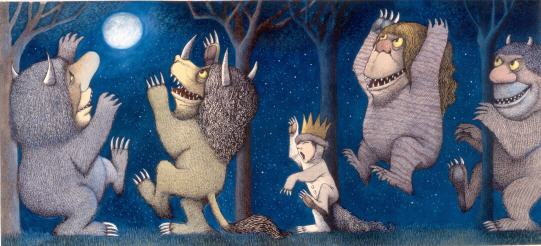

Related programming Sendak Preschool Time

The 2015 TD Gallery season is generously sponsored by TD Bank Group.ĭecember 21, January 11, and January 25, 2016. Special thanks to the lenders to the exhibition and to AFANYC for their support.Īdditional support provided by the Friends of the Osborne Collection. Maurice Sendak: 50 Years, 50 Works, 50 Reasons exhibition tour is managed by Opar Media, LLC. The exhibition also features artwork from the Toronto Public Library's Osborne Collection of Early Children's Books. The works on display highlight Sendak's range as an artist - beloved characters from Where the Wild Things Are and In the Night Kitchen, set and costume designs, animation cels, posters, and sketches for fans and close friends. See more than 50 works spanning Sendak's acclaimed career, including sketches, illustrations and works on paper. In celebration of the 50th anniversary of its publication, Toronto Public Library presents a retrospective exhibition of original artwork by the book's revered author and illustrator, Maurice Sendak. The story of a disobedient boy with a fierce imagination, Where the Wild Things Are is one of the most beloved children's books of all time. It’s almost like a vignette of the monsters’ lives told from the perspective of the child king that got away.TD Gallery at the Toronto Reference Library Things happen and subplots advance but there is no actual story told. The story didn’t really seem to say anything or do anything. Unfortunately the whole is greater than the sum of its parts, and these great parts did not mesh well to create an excellent whole. Tensions run high amongst the volatile monsters, with plenty of threats to eat each other and a comment by KW that Max “is the first king we didn’t eat.”ġ2-year-old actor Max Record’s portrayal of the nine year old main character Max is believable, from his childish seriousness when it comes to building a snow fort stocked with snowballs to the innocent way he defends a friend who just moments ago was trying to eat him.įor being 10-foot tall puppets stuffed with actors and CGI limited to enhancing facial expressions and Olympic worthy jumps, the monsters have well done performances, bridge the gap between grown-up emotions and childish reactions.Ī whimsical indie soundtrack works consistently in the background to reinforce the fact that you are not in an absurd adult world, you are in a serious kids’ kingdom. The monsters have complex relationships and “deep” emotions, leaving the viewer with the feeling that there’s always a more relevant story here that is briefly explained. Judith, a shaggy creature cross between a rhino and a lion, is extremely self-centered and critical traits complement Ira, a big-nosed beast who craves any attention, good or bad.Īlexander, a bipedal goat, is the smallest of the monsters and constantly left behind by the others, yet always trying to match them in any and all activities.

#Let the wild rumpus start movie
Carol spends most of the movie upset that KW is growing distant from the main group, while KW tries to reconcile her old group of friends with her new friends. That relationship is echoed between Carol and KW, the shaggy monster with long duck feet. His tantrums echo scenes where a frustrated Max trashes his teen sister’s room after she leaves him to hangout with her friends. Being lonely, the boy returns home where he finds a meal waiting for him…”and it was still hot.”Īside from some comical exaggerations and fantastic sets, there isn’t really much here for children despite the material being drawn from a children’s book.Instead of a light story about a child’s imagination, the movie has the feel of an adult trying to apply depth and importance to a child’s game of make believe.Įach monster is a clear allusion to some of the conflicting emotions of Max’s personality until he is no longer his own unique character, but rather just another facet of his own personality his own conscience trying to keep his emotions in check.Ĭarol, a horned, scaly bear monster, has high hopes and a short temper. Afterwards a vindictive Max sends them to bed without supper. Trapped there, Max imagines a jungle and ocean engulfing his room, eventually taking him to an island where “the wild things are.” They declare him their king after he tames them and starts the rumpus.

His mother eventually sends him to his room without dinner. It opens with Max racing around causing “mischief of one kind or another” while wearing his iconic wolf costume. When the original was written by Maurice Sendak, it was among the first children’s book that dealt with the “unhappy” emotions of childhood. Where the Wild Things Are takes a classic nine-sentence children’s story and translates it into a fantastic muppet soap opera.


 0 kommentar(er)
0 kommentar(er)
